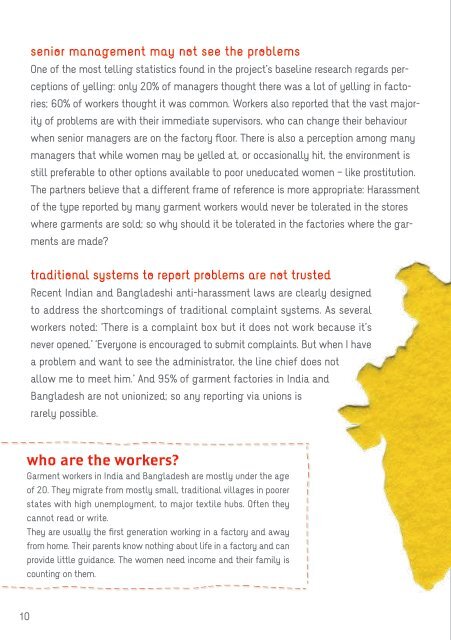STANDING FIRM AGAINST FACTORY FLOOR HARASSMENT
report - Fair Wear Foundation
report - Fair Wear Foundation
- No tags were found...
Create successful ePaper yourself
Turn your PDF publications into a flip-book with our unique Google optimized e-Paper software.
senior management may not see the problems<br />
One of the most telling statistics found in the project’s baseline research regards perceptions<br />
of yelling: only 20% of managers thought there was a lot of yelling in factories;<br />
60% of workers thought it was common. Workers also reported that the vast majority<br />
of problems are with their immediate supervisors, who can change their behaviour<br />
when senior managers are on the factory floor. There is also a perception among many<br />
managers that while women may be yelled at, or occasionally hit, the environment is<br />
still preferable to other options available to poor uneducated women – like prostitution.<br />
The partners believe that a different frame of reference is more appropriate: Harassment<br />
of the type reported by many garment workers would never be tolerated in the stores<br />
where garments are sold; so why should it be tolerated in the factories where the garments<br />
are made?<br />
traditional systems to report problems are not trusted<br />
Recent Indian and Bangladeshi anti-harassment laws are clearly designed<br />
to address the shortcomings of traditional complaint systems. As several<br />
workers noted: ‘There is a complaint box but it does not work because it’s<br />
never opened.’ ‘Everyone is encouraged to submit complaints. But when I have<br />
a problem and want to see the administrator, the line chief does not<br />
allow me to meet him.’ And 95% of garment factories in India and<br />
Bangladesh are not unionized; so any reporting via unions is<br />
rarely possible.<br />
India<br />
Sumangali<br />
Under the Sumangali scheme, a form of forced labour common in Tamil Nadu, India,<br />
girls’ parents are persuaded by brokers to sign up their daughter(s). These families<br />
are usually poor and from the lower castes. The scheme promises an attractive sum<br />
of money after completion of a three-year contract working in the factory.<br />
Once the contract is signed, young girls are under the control of the factory or the<br />
broker. It is often reported that the girls live in captivity for a long period. Girls are<br />
often forced to work up to 12 hours a day, live in hostels with few facilities, and<br />
earn a very low wage.<br />
Approximately 60% of the factory<br />
workers have experienced some<br />
type of harassment at work, verbal<br />
abuse or physical abuse.<br />
Bangladesh<br />
who are the workers?<br />
Garment workers in India and Bangladesh are mostly under the age<br />
of 20. They migrate from mostly small, traditional villages in poorer<br />
states with high unemployment, to major textile hubs. Often they<br />
cannot read or write.<br />
They are usually the first generation working in a factory and away<br />
from home. Their parents know nothing about life in a factory and can<br />
provide little guidance. The women need income and their family is<br />
counting on them.<br />
70%<br />
of the 7 million<br />
workers are female<br />
80%<br />
of the 3.6 million<br />
workers are female<br />
10 11










